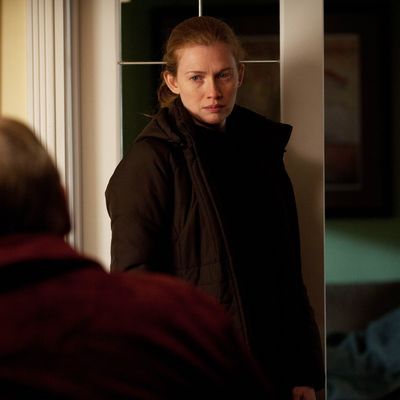
Season two of The Killing begins with a close-up of hands being washed, and it feels like a sly acknowledgement of the viewer revolt that took place during season one. Lots of viewers, myself included, welcomed the show and hoped it would deliver what AMC’s advance PR seemed to promise: a magnificently gloomy whodunit that showed how a single murder disrupted a community. But the AMC drama devolved from a promisingly atmospheric procedural into a Law & Order: Criminal Intent episode stretched out over what felt like 582 weeks, chock-full of red herrings that felt more like time-wasters than thematically defensible detours, and viewers washed their hands of it. The Killing was an infuriating series not because it was so shamelessly, at times absurdly manipulative (many good dramas are), but because both its marketing campaign and its aesthetic promised a deeper experience than the show actually delivered. There’s no point slowing a story to a crawl when there’s nothing new to see.
The first couple of episodes of season two (shown back-to-back Sunday at 8 p.m.) suggest that showrunner Veena Sud and company got the memo, skimmed it, then handed it off to co-star Joel Kinnaman to use as rolling paper. The stubborn bastard in me admires how the show seems to be sticking with whatever revolutionary aesthetic it believes it nurtured last year. But it’s still amazing how little new information you actually get each week. The premiere episodes each contain one or two modest (and knowing this series, probably useless) revelations, plus a whole lot of brooding and drizzle. The acting, direction, photography, editing, and sound design are so superb that you may momentarily think you’re seeing a vastly improved Killing, but after a moment you’ll realize that it was always aces in those departments and that the show’s weakest link, the writing, hasn’t improved all that much. The striking, almost abstract close-ups of city councilman’s Darren Richmond’s hand as he’s rushed to the hospital following the attempt on his life; the synthesized thrum-thrum score; the nonstop rain that makes it seem as though the whole story is taking place in Ridley Scott’s imagination; the shots of star Mireille Enos’s stricken face when detective Sarah Linden tells her son they’re not leaving Seattle after all (“I’m sorry, sometimes things don’t work out,” she tells the boy, as if she’s breaking up with him): These touches and others made me think, This show is pretty good. Why didn’t I like it? Then the characters started talking and I remembered.
Who killed Rosie Larsen? We’ll find out by the end of this season, according to Sud. In the meantime, the series seems inclined to make the teenager’s murder into a piece of a larger conspiracy that seems to involve the entire city of Seattle. Linden’s ganja-scented partner, Holder (Kinnaman), who was involved in that phony surveillance camera photo scam at the bridge and has now been rewarded with a promotion by his shadowy puppet masters, isn’t the only bad egg stinking up Sarah’s world. Everywhere she goes she gets stone-walled, often by officials whose cold demeanor and knowing expressions suggest they’ve been body-snatched. A surgeon casually reports that Richmond might bleed to death even if surgery is successful, then strolls away without another word. An administrator asks the councilman’s aide and lover, Gwen Eaton (Kristin Lehman), if the councilman was religious, strategically withholding why she’s asking (last rites), then walks off, clutching her clipboard. Cue Rick Moranis in Spaceballs declaring, “I knew it! I’m surrounded by assholes!”
Richmond’s assailant Belko Royce (Brendan Sexton III) and Rosie’s dad Stan (Brent Sexton) have a powerful interrogation-room scene in which Belko, an emotionally arrested man-child, alludes to their shared history of murder; Stan’s exhausted face seems to crater with guilt, as if he’s wondering if his daughter’s death amounts to karmic scale-balancing. But these moments and others are gems in mud. The Killing is still CBS potboiler hackwork wrapping itself in art-house pretension. The problem ultimately isn’t that the show is ludicrous, but that it’s not ludicrous enough. Despite very slight improvements, this series still seems deluded as to what it is and blind to what it could become. And that’s too bad. If Sud and company had the courage (or the ability) to be truly, deeply, delightfully weird and drive the whole thing in a more Twin Peaks/American Horror Story–type of direction, viewer gripes about pacing problems, inconsistent characterizations, and yanked-from-the-writers’-alimentary-canal plot twists would disappear, and The Killing might seem like a vibrantly nasty pleasure: a hothouse flower nourished by gloomy rain.


